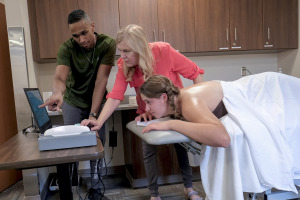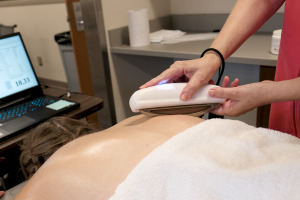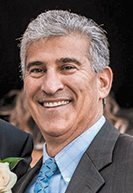Subscriber Benefit
As a subscriber you can listen to articles at work, in the car, or while you work out. Subscribe Now
Terry Loghmani has been massaging patients’ sore muscles and damaged tissue for more than 30 years as a physical therapist and massage therapist.
After so many years in the clinic and as associate professor of physical therapy at Indiana University School of Health & Human Sciences in Indianapolis, she can see when her hands-on work helps patients improve.
But for most of that time, she has had less insight into a critical part of her therapy: exactly how much force she was using, and which stroke patterns, directions, angles and motions were most helpful.
Now she and two colleagues have developed a medical device they say can help physical therapists monitor the level of pressure they apply to the soft tissue of patients seeking greater mobility and pain relief.
Their startup company, Health Smart Technologies, has developed a device system called QSTM (for quantifiable soft tissue manipulation) that allows clinicians to monitor and record the type of manual therapy forces they’re providing with a goal to make therapy even more scientific and useful.

She likened her devices to Fitbit technology, which measures workouts by recording heart rate, steps taken, calories burned and other markers of activity and intensity.
Health Smart, formed in 2016, has raised approximately $450,000 in grants to develop and research digital technology.
“Our goal is not to replace the therapists’ hands-on procedures with clients,” she said. “We want to augment it with a device that can quantify what the therapist is doing.”
The device is in the prototype stage and was recently licensed exclusively by Indianapolis-based Boomerang Ventures as the lead product in a new portfolio company called BVS Muscle.
If the device gets approval from the U.S. Food and Drug Administration, it could find a huge market. Millions of Americans suffer from soft-tissue damage, such as strains, stress injuries and contusions, either from trauma or overuse.
The global soft tissue repair market was estimated at $6.6 billion in 2022 and could reach $11.6 billion by 2032, according to Future Market Insights, a market research firm based in Newark, Delaware.
Around the country, millions of physical therapists, athletic trainers, chiropractors and others are using a variety of tools to help patients recover, but they have no way to monitor how much pressure they’re applying to soft tissue. That makes it challenging to monitor a patient’s treatment and recovery.
Officials at Graston Technique LLC, an Indianapolis company that provides soft-tissue repair training to thousands of therapists a year, have been keeping an eye on Loghmani’s work and say she is filling a critical need.

“The hardest thing to teach is how much pressure to use,” said Dominic Merlina, CEO of Graston Technique. “You can teach the anatomy and the grooves of the muscles and tendons and ligaments. But how much pressure to apply is one of the most skilled arts in the industry.”
And what Loghmani wants to do is to take therapy from a skilled art to more of a science, with data that can be used in clinical care, research and education.
Today, when therapists use tools for soft-tissue massage, they try to measure it with low, medium or high force.
“But that is so subjective,” she said. “My low force can be your high force.”
Loghmani, a former clinical director for Graston Technique (when it was called TherapyCare) said there are currently no clinical methods to quantify the force and motion variables used in therapeutic massage. That can lead to widely inconsistent treatments from one session to another, or from one therapist to another.
She also hopes the device can help in research with controlled clinical trials that will accurately measure the amount of pressure clinicians apply with their hands and instruments. Loghmani holds a doctorate from Indiana University in anatomy and cell biology. Her teaching is focused on the foundations of physical therapy examination and assessment.
The young company has two handheld devices and a software system for measuring soft-tissue manipulation. A metal tip on each device transmits the applied forces to a sensor that measures force by height, width and depth, then sends those measurements to a microprocessor.
The microprocessor—aided by a gyroscope—computes the pressure, angle, duration and stroke frequency of the tool, which allows the system to determine the force and motion the therapist is using.
The information can be displayed on a laptop computer or a tablet for real-time monitoring and data recording.

Loghmani teamed up with two engineers from Purdue University’s School of Engineering and Technology to develop the system. Sohel Anwar, professor of mechanical engineering, designed the instruments that incorporated sensors and electronics. Stanley Chien, professor of electrical and computer engineering, designed the software system.
Today, the three are co-founders of Health Smart Technologies. In addition, Loghmani is company president, Anwar is CEO, and Chien is chief scientific officer.
Anwar said designing the system was complex on many levels, from fitting all the electronics into a small device to designing an algorithm that could provide meaningful data on force, angle, motion and stroke counts.
“We had to combine about four sets of data and make sure they were accurate,” he said.
The next engineering challenge, Anwar said, is to design a wireless system and get cloud connectivity. Currently, the system uses wires that connect the instruments and the computer, and stores information directly into the laptop or tablet.
In addition, Health Smart worked for three years with engineers at Rose-Hulman Institute of Technology in Terre Haute, who helped design the ergonomics of the devices.
The startup licensed the technology from the Indiana University Innovation and Commercialization Office, which markets and licenses intellectual property developed at the university.
In turn, Health Smart has found a backer, Boomerang Ventures, a combination venture studio and funding source that leverages health care technology. The company said Loghmani’s background in academic research and clinical treatment was one of the main reasons it was interested in the device.
“This technology revolutionizes the manual therapy industry and does a phenomenal job of helping patients,” Dick Aderman, studio director of Boomerang Technologies, said in a statement. “Bringing health care products to life from universities is textbook for us.”
The venture firm’s portfolio includes startups in respiratory health, women’s health, mental health and home-care software.
Loghmani said the company is still months from submitting the device for FDA review but is moving forward with testing and is “on the regulatory pathway.”
The company goal is to have a commercial launch in early 2025 and to make the technology available worldwide to clinicians who use manual therapy.
“I want to optimize physical therapy,” Loghmani said, “for consistent, effective care.”•
Please enable JavaScript to view this content.

